The Rules Guy: After You Cross the Finishing Line
Jan 31, 2024
I had the opportunity to spend a weekend with 60 University sailors from ten different Universities who were racing the Canadian Intercollegiate Sailing Association (CICSA) Team Racing championships. Team racing is fun part of the sport and a great way to exercise a lot of rules in a short time. There were 40 races over two days.
I have previously wrote about how to finish when the marks aren’t quite where you expect them to be. Now I would like to discuss what happens after your cross the line. Some of the situations in this article and the next one occurred over the weekend.

In the first diagram, Red on port tack tries to cross Green on starboard tack. Green realized that they are going to hit and tacks to avoid the collision, while hailing “protest”. Red crosses the line from the course side at position 2. According to the first part of the definition of finish she has finished. Red realizes that she has broken the rule and takes a penalty. In this race, the penalty is one turn, so she has to do a tack followed by a gybe (or a gybe followed by a tack). She tacks between position 2 and position 4 and then gybes between position 5 and position 6. She then crosses the line again at position 8. The first exception (a) in the definition of finish says that Red has not finished if she takes a penalty after crossing the finishing line, so Red did not finish at position 2. She finishes just before position 8. She would be scored after Green who crossed at position 3.
The same interpretation applies if the penalty was one imposed by an umpire or judge just before or just after a boat crosses the finishing line. It also applies if the penalty is two turns instead of one. I have not drawn this since the diagram gets very crowded. The important part is that the boat can do the tacks and gybes anywhere relative to the finishing line but has to be completely on the course side of the line after the tacks and gybes are done, before crossing the line again.

The second diagram illustrates the second exception. For reasons that are not clear, Yellow passes the finishing mark on the wrong side and then crosses the line towards the last mark at position 5. Since she has not crossed from the course side, she has not finished. She realizes her mistake and starts to unwind her course. When she crosses the line from the course side at position 8, she meets the first part of the definition of finish. She continues to sail around the mark and crosses the line from the course side at position 14. She has now corrected her error in sailing the course so the second exception (b) in the definition applies and she did not finish when she first crossed. She only finishes as position 14.
These situations are confusing for the race committee. They will usually take note of every crossing, but only score based on the last one. If for some reason you end up crossing again after your real finish, you may need to let the race committee know.
| Finish A boat finishes when, after starting, any part of her hull crosses the finishing line from the course side. However, she has not finished if after crossing the finishing line she (a) takes a penalty under rule 44.2, (b) corrects an error in sailing the course made at the line, or (c) continues to sail the course. Sail the Course A boat sails the course provided that a string representing her track from the time she begins to approach the starting line from its prestart side to start until she finishes, when drawn taut, (a) passes each mark of the course for the race on the required side and in the correct order, (b) touches each mark designated in the sailing instructions to be a rounding mark, and (c) passes between the marks of a gate from the direction of the course from the previous mark. 28 SAILING THE RACE 28.1 A boat shall start, sail the course and then finish. While doing so, she may leave on either side a mark that does not begin, bound or end the leg she is sailing. After finishing she need not cross the finishing line completely. 28.2 A boat may correct any errors in sailing the course, provided she has not crossed the finishing line to finish. 44.2 One-Turn and Two-Turns Penalties After getting well clear of other boats as soon after the incident as possible, a boat takes a One-Turn or Two-Turns Penalty by promptly making the required number of turns in the same direction, each turn including one tack and one gybe. When a boat takes the penalty at or near the finishing line, her hull shall be completely on the course side of the line before she finishes. |

Andrew Alberti is an International Judge and National Umpire. He is a member of the Sail Canada Rules and Appeals Committees. Send your questions to Andrew at kyrules@alberti.ca















